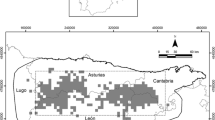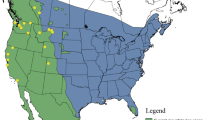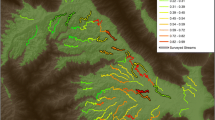Abstract
We examined whether spatially explicit information improved models that use LiDAR return signal intensity to discriminate in-pond habitat from terrestrial habitat at 24 amphibian breeding ponds. The addition of Local Indicators of Spatial Association (LISA) to LiDAR return intensity data significantly improved predictive models at all ponds, reduced residual error by as much as 74%, and appeared to improve models by reducing classification errors associated with types of in-pond vegetation. We conclude that LISA statistics can help maximize the information content that can be extracted from time resolved LiDAR return data in models that predict the occurrence of small, seasonal ponds.



Similar content being viewed by others
References
Akaike H (1973) Information theory and an extension of the maximum likelihood principle. In: Petran BN, Csáaki F (eds) Second international symposium on information theory. Akadéemiai Kiadi, Budapest, pp 267–281
Anselin L (1995) Local indicators of spatial association: LISA. Geogr Anal 27:93–115
Anselin L (2003) GeoDa 0.9 user’s guide. Spatial analysis laboratory (SAL), Department of agricultural and consumer economics, University of Illinois, Urbana-Champaign, IL, USA
Antonarakis AS, Richards KS, Brasington J (2008) Object-based land cover classification using airborne LiDAR. Remote Sens Environ 112:2988–2998. doi:10.1016/j.rse.2008.02.004
Brock JC, Wright CW, Sallenger AH, Krabill WB, Swift RN (2002) Basis and methods of NASA airborne topographic mapper lidar surveys for coastal studies. J Coast Res 18:1–13
Brooks RT, Stone J, Lyons P (1998) An inventory of seasonal forest ponds on the Quabbin reservoir watershed, Massachusetts. Northeastern Nat 5:219–230. doi:10.2307/3858622
Burnham KP, Anderson DR (eds) (2002) Model selection and multimodal inference, 2nd edn. Springer, New York
Calhoun AJK, Walls TE, Stockwell SS, McCollough M (2003) Evaluating vernal pools as a basis for conservation strategies: a maine case study. Wetlands 23:70–81. doi:10.1672/0277-5212(2003)023[0070:EVPAAB]2.0.CO;2
Campbell JB (1987) Introduction to remote sensing. The Guilford Press, New York
Chust G, Galparsoro I, Borja A, Franco J, Uriarte A (2008) Coastal and estuarine habitat mapping, using LIDAR height and intensity and multi-spectral imagery. Estuar Coast Shelf Sci 78:633–643. doi:10.1016/j.ecss.2008.02.003
Comer P, Goodin K, Tomaino A, Hammerson G, Kittel G, Menard S, Nordman C, Pyne M, Reid M, Sneddon L, Snow K (2005) Biodiversity values of geographically isolated wetlands in the United States. NatureServe, Arlington
Donoghue DNM, Watt PJ, Cox NJ, Wilson J (2007) Remote sensing of species mixtures in conifer plantations using LiDAR height and intensity data. Remote Sens Environ 110:509–522. doi:10.1016/j.rse.2007.02.032
Dubayah RO, Drake JB (2000) Lidar remote sensing for forestry. J For 98:44–46
Fike J (1999) Terrestrial and palustrine plant communities of Pennsylvania. Pennsylvania Natural Diversity Inventory, Pennsylvania Department of Conservation and Recreation, Bureau of Forestry, Harrisburg, PA, USA 86pp
Gibbs JP (1998) Distribution of woodland amphibians along a forest fragmentation gradient. Landsc Ecol 13:263–268. doi:10.1023/A:1008056424692
Grant EHC (2005) Correlates of vernal pool occurrence in the Massachusetts, USA landscape. Wetlands 25:480–487. doi:10.1672/22
Grossman DH, Faber-Langendoen D, Weakley AS, Anderson M, Bourgeron P, Crawford R, Goodin K, Landaal S, Metzler K, Patterson KD, Pyne M, Reid M, Sneddon L (1998) International classification of ecological communities: terrestrial vegetation of the United States, vol I. The National vegetation classification system: development, status, and applications. The Nature Conservancy, Arlington, VA, USA
Kutner MH, Nachtsheim CJ, Neter J (eds) (2004) Applied linear regression models, 4th edn. McGraw-Hill Irwin, Boston
Palik BJ, Buech R, Egeland L (2003) Using an ecological land hierarchy to predict seasonal-wetland abundance in upland forests. Ecol Appl 13:1153–1163. doi:10.1890/1051-0761(2003)13[1153:UAELHT]2.0.CO;2
Phinn SR, Stow DA, Franklin J, Mertes LA, Michaelsen J (2003) Remotely sensed data for ecosystem analysis: combining hierarchy theory and scene models. Environ Manage 31:429–441. doi:10.1007/s00267-002-2837-x
Ping JL, Green CJ, Zartman RE, Bronson KF (2004) Exploring spatial dependence of cotton yield using global and local autocorrelation statistics. Field Crops Res 89:219–236. doi:10.1016/j.fcr.2004.02.009
Portnoy JW (1987) Vernal ponds of the Cape Cod National Seashore: location, water chemistry, and Ambystoma breeding biology. Unpublished report. US National Park Service, Cape Cod National Seashore, Wellfleet, MA, USA
Roth AH, Jackson JF (1987) The effect of pool size on recruitment of predatory insects and on mortality in larval anuran. Herpetologica 43:24–232
Schneider DW, Frost TM (1996) Habitat duration and community structure in temporary ponds. J N Am Benthol Soc 15:64–86. doi:10.2307/1467433
Semlitsch RD (2000) Principles for management of aquatic-breeding amphibians. J Wildl Manage 64:615–631. doi:10.2307/3802732
Semlitsch RD, Bodie JR (1998) Are small, isolated wetlands expendable? Conserv Biol 12:1129–1133. doi:10.1046/j.1523-1739.1998.98166.x
Shi H, Zhang L (2003) Local analysis of tree competition and growth. For Sci 49:938–955
Skelly DK (1996) Pond drying, predators, and the distribution of Pseudacris tadpoles. Copeia 1996:599–605. doi:10.2307/1447523
Snyder CD, Julian JT, Young AJ, King TL (2005) Assessment of Ambystomatid salamander populations and their breeding habitats in Delaware Water Gap National Recreation Area. Report submitted to National Park Service, Delaware Water Gap National Recreation Area, 51 p
Song JH, Han SH, Yu K, Kim YI (2002) Assessing the possibility of land-cover classification using LiDAR intensity data. In: ISPRS Commission III, Symposium 2002, 9–13 September 2002, Graz, Austria
Southworth J, Monroe D, Nagendra H (2004) Land cover change and landscape fragmentation—comparing the utility of continuous and discrete analyses for a western Honduras region. Agric Ecosyst Environ 101:185–205. doi:10.1016/j.agee.2003.09.011
Strahler AH, Woodcock CE, Smith JA (1986) On the nature of models in remote sensing. Remote Sens Environ 20:121–139. doi:10.1016/0034-4257(86)90018-0
Stone JS (1992) Vernal pools in Massachusetts: aerial photographic identification, biological and physiographic characteristics, and state certification criteria. Master’s Thesis. University of Massachusetts, Amherst, MA, USA
Tiner RW (2003) Estimating the extent of geographically isolated wetlands in selected area of the United States. Wetlands 23:636–652. doi:10.1672/0277-5212(2003)023[0636:EEOGIW]2.0.CO;2
Townsend PA (2001) Mapping seasonal flooding in forested wetlands using multi-temporal radarsat SAR. Photogram Eng Remote Sensing 67:857–864
Wehr A, Lohr U (1999) Airborne laser scanning—an introduction and overview. J Photogrammetry Remote Sens 54:68–82. doi:10.1016/S0924-2716(99)00011-8
Woodward BD (1983) Predator prey interactions and breeding pond use of temporary pond species in a desert anuran community. Ecology 64:1549–1555. doi:10.2307/1937509
Wright CW, Brock JC (2002) EAARL: a LiDAR for mapping shallow coral reefs and other coastal environments. In: Proceedings of seventh international conference on remote sensing for marine and coastal environments, Miami, FL, USA, 20–22 May 2002
Wright C, Gallant A (2007) Improved wetland remote sensing in Yellowstone National Park using classification trees to combine TM imagery and ancillary environmental data. Remote Sens Environ 107:582–605. doi:10.1016/j.rse.2006.10.019
Wright CW, Riordan K, Noronha C (2003) Advancement in LiDAR data collection: NASA’s experimental advanced airborne research LiDAR. In: Proceedings of the 3rd biennial costal GeoTools conference, Charleston, SC, USA, 6–9 January 2003
Author information
Authors and Affiliations
Corresponding author
Rights and permissions
About this article
Cite this article
Julian, J.T., Young, J.A., Jones, J.W. et al. The use of local indicators of spatial association to improve LiDAR-derived predictions of potential amphibian breeding ponds. J Geogr Syst 11, 89–106 (2009). https://doi.org/10.1007/s10109-008-0074-4
Received:
Accepted:
Published:
Issue Date:
DOI: https://doi.org/10.1007/s10109-008-0074-4




